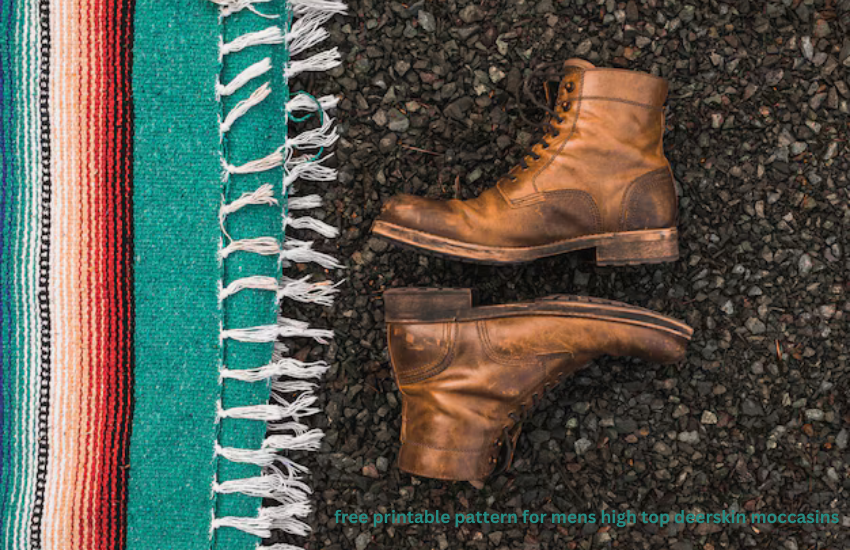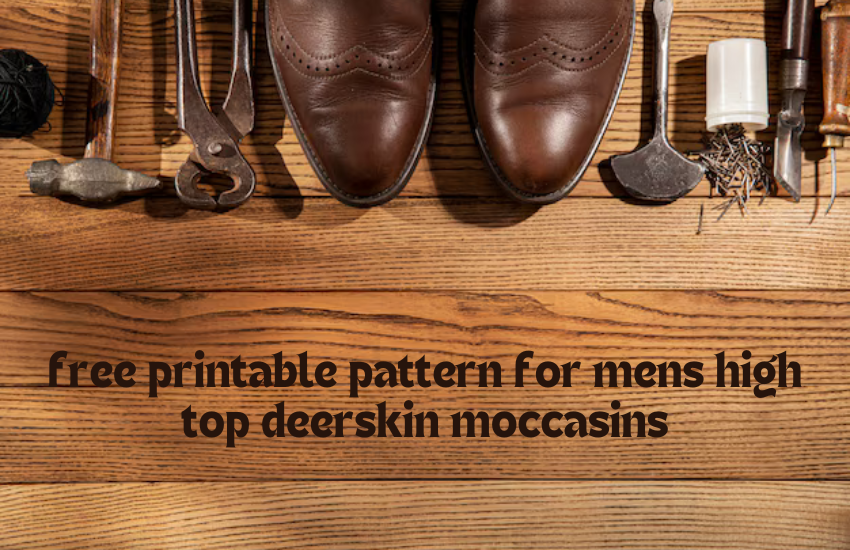History and Significance of Moccasins
Moccasins have a rich history dating back centuries, primarily used by Native American tribes across North America. They were crafted for functionality, providing protection and comfort for long periods of walking or running.
Types of Moccasins
There are various types of moccasins, including low-cut, ankle-high, and high top versions. Each style serves different purposes, from everyday wear to ceremonial uses.
Popularity of High Top Moccasins
High top moccasins are particularly popular due to their enhanced support and stylish appearance. They are versatile, suitable for both indoor and outdoor activities.
Benefits of Deerskin for Moccasins
Deerskin is an excellent choice for crafting moccasins, offering several advantages over other types of leather.
Durability and Comfort
Deerskin is known for its durability and soft, supple texture. It molds to the feet, providing a custom fit that enhances comfort.
Breathability and Flexibility
The natural fibers in deerskin allow for breathability, preventing moisture buildup and keeping feet dry. Its flexibility ensures ease of movement.
Eco-Friendly Aspects
Deerskin is often sourced as a byproduct of managed wildlife populations, making it a more sustainable option compared to other leathers.
Materials Needed
Before starting your moccasin project, gather all necessary materials to ensure a smooth crafting process.
Deerskin Leather
Choose high-quality deerskin leather for the best results. It should be thick enough to provide durability but still soft and flexible.
Thread and Needles
Use strong, durable thread specifically designed for leatherworking. A variety of needles may be needed, including glover’s needles for piercing the leather.
Patterns and Templates
Printable patterns are essential. They provide the blueprint for your moccasins, ensuring all pieces fit together correctly.
Additional Supplies
Other supplies include an awl for making holes, scissors for cutting, and a ruler for precise measurements.

Tools Required
Having the right tools is crucial for crafting high-quality moccasins.
Sewing Tools
A sturdy sewing awl, leather needles, and strong thread are essential for stitching the leather pieces together.
Cutting Tools
Sharp scissors or a rotary cutter will ensure clean, precise cuts of the leather.
Measuring Tools
A ruler or measuring tape will help in accurately cutting and aligning the pieces.
Understanding Moccasin Patterns
Patterns are the foundation of your moccasin project. Understanding how to read and adjust them is key.
Basic Components of a Pattern
Moccasin patterns typically include pieces for the sole, vamp (upper part), and sometimes a cuff or ankle wrap.
Reading and Interpreting Patterns
Carefully study the pattern to understand how each piece fits together. Pay attention to markings and instructions.
Adjusting Patterns for Size
Ensure the pattern is adjusted to fit your foot size. This may involve scaling the pattern up or down or making minor modifications for a perfect fit.
Step-by-Step Guide to Making High Top Deerskin Moccasins
Follow these detailed steps to craft your own high top deerskin moccasins.
Preparing the Deerskin
Start by preparing your deerskin. Ensure it is clean and free of imperfections. Lay it flat and smooth out any wrinkles.
Cutting the Pattern Pieces
Place the pattern pieces on the deerskin and trace them using a fine-point marker. Cut out each piece carefully.
Sewing the Upper Parts
Begin by sewing the upper parts of the moccasins. This typically involves stitching the vamp to the sides. Use strong, even stitches for durability.
Attaching the Sole
Align the sole with the upper part and stitch them together. Ensure the stitching is secure and even to prevent any gaps.
Finishing Touches
Finish your moccasins by adding any decorative elements, such as beads or stitching patterns. Ensure all edges are smooth and finished.
Customizing Your Moccasins
Personalizing your moccasins can make them unique and special.
Adding Personal Touches
Consider adding initials, symbols, or other personal touches to your moccasins.
Dyeing and Staining Deerskin
Use leather dyes or stains to change the color of the deerskin. Follow the manufacturer’s instructions for best results.
Decorative Stitching and Beading
Add decorative stitching or beading to enhance the appearance of your moccasins. Be creative and experiment with different designs.
Tips for a Perfect Fit
A perfect fit is crucial for comfort and functionality.
Measuring Your Feet
Accurately measure your feet before cutting the pattern. Consider the thickness of the deerskin when making your measurements.
Adjusting the Pattern
Make any necessary adjustments to the pattern to ensure a snug fit. Test fit the pieces before final stitching.
Test Fitting
Once the moccasins are partially assembled, try them on to check the fit. Make any final adjustments as needed.
Caring for Deerskin Moccasins
Proper care will extend the life of your moccasins.
Cleaning and Maintenance
Regularly clean your moccasins with a soft brush and mild soap. Avoid harsh chemicals that can damage the leather.
Waterproofing and Protection
Apply a leather conditioner or waterproofing spray to protect your moccasins from moisture and stains.
Repairing and Resoling
If your moccasins show signs of wear, repair them promptly. Replace the sole if it becomes too worn.
Troubleshooting Common Issues
Address common issues to keep your moccasins in top condition.
Common Sewing Mistakes
Avoid common sewing mistakes such as uneven stitches or improperly aligned pieces.
Fit Issues
If your moccasins are too tight or too loose, make adjustments to the pattern or stitching.
Durability Problems
Ensure you use strong, high-quality materials and stitching techniques to enhance durability.
Advanced Techniques
For those looking to refine their skills, explore advanced moccasin-making techniques.
Advanced Stitching Methods
Learn advanced stitching methods for a more professional finish.
Complex Designs and Patterns
Experiment with complex designs and patterns to create unique moccasins.
Professional Finishing Techniques
Apply professional finishing techniques for a polished look.

Frequently Asked Questions (FAQs)
How long does it take to make a pair of moccasins?
The time required varies, but typically ranges from a few hours to a couple of days depending on your skill level and the complexity of the design.
Can I use other types of leather?
Yes, while deerskin is preferred for its softness and flexibility, other types of leather can be used.
How do I ensure my moccasins are waterproof?
Use a waterproofing spray specifically designed for leather to protect your moccasins from moisture.
Is deerskin ethical and sustainable?
Deerskin is often considered a byproduct of wildlife management programs, making it a more sustainable choice.
What are the best patterns for beginners?
Simple, low-cut moccasin patterns are best for beginners. They require fewer pieces and less complex stitching.
How can I make moccasins more durable?
Use high-quality materials and strong stitching techniques. Regularly maintain and repair your moccasins to extend their life.
Resources and Templates
Utilize available resources and templates for guidance and support.
Printable Patterns
Find free printable patterns online from reputable sources.
Online Tutorials
Watch online tutorials to follow along with step-by-step instructions.
Community Forums and Support Groups
Join community forums and support groups for tips and advice from fellow moccasin makers.
Conclusion
Crafting your own men’s high top deerskin moccasins can be a rewarding experience. With the right materials, tools, and techniques, you can create a pair of moccasins that are not only functional but also personalized to your style and preferences. Take your time, follow the steps carefully, and enjoy the process of making something truly unique.
Additional Resources
For further learning and support, consider these additional resources.
Books and Guides on Moccasin Making
Explore books and guides that offer in-depth information on moccasin making.
Where to Buy Quality Deerskin
Find reputable suppliers of quality deerskin leather.
Workshops and Classes
Attend workshops and classes to improve your skills and connect with other enthusiasts.


